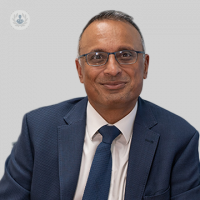Joint Preservation; how to keep the young active for longer
Written in association with:Joint preservation is a rapidly emerging field in orthopaedics that has evolved because of the limitations in joint replacement surgery. Surgeons have turned to joint preservation to prevent or delay arthritis and other degenerative conditions, particularly in young patients. Joint preservation, in essence, is a procedure to prevent or delay knee replacement surgery.
Here to tell us more about preserving the knee joint, is orthopaedic surgeon Mr Paul Trikha.

What is the purpose of joint preservation surgery?
The purpose of joint preservation surgery is to use all available technology and techniques to preserve natural joints, before replacing them via surgery. The goal of preservation is to prevent injury, reduce inflammation and repair and restore damaged cartilage.
How is knee joint preservation surgery carried out?
Knee preservation surgery can be achieved through arthroscopy and minimally invasive surgical techniques. Keyhole surgery techniques are frequently used to repair meniscus tears.
The key knee preservation techniques are correcting alignment, creating stability in the joint by reconstructing or repairing ligaments and preserving the meniscus or even replacing the meniscus with a transplant.
Creating stability
The knee can be stabilised by reconstructing and repairing ligaments wherever possible and by repairing or restoring articular surface cartilage. New techniques allow stem cells to enter the damaged joint. The stem cells are taken from the patient’s bone marrow with a small needle and centrifuged in a special machine.
This provides a concentrated amount of stem cells to be transplanted into the knee joint, creating new cartilage cells to repair the damaged part of the joint.
Correcting alignment
Correct alignment is very important to preserve a joint. Those with bowlegs or knock-knees may require an osteotomy to correct knee alignment and offload pressure from the joint.
A thorough clinical assessment, with Xrays, CT scans and MRI scans are needed to assess the suitability of these procedures for patients.
Why is joint preservation useful for younger generations?
In young people with osteoarthritis, surgery should never be the first choice. Joints should be preserved for as long as possible. Joint replacement parts do last longer than previously, however, they are very mechanical and subject to loosening and stiffness, and further replacements may be needed over time.
If cartilage damage has occurred, this cannot be reversed, but joint preservation techniques as mentioned above, can reduce and delay joint degeneration caused by osteoarthritis and delay the need for partial or total knee replacement.
What non-surgical techniques are used for joint preservation?
Joint preservation does not necessarily start with minimally invasive surgery. A number of non-surgical techniques are used to preserve the joint.
Non-surgical techniques used to preserve the joint, include:
- Weight loss; to offload extra weight from the painful joint.
- Activity modification.
A prescribed exercise programme to strengthen muscles and correct any biomechanical problems
- An unloader brace; to support the damaged joint and offload extra weight.
- Injection therapy; Common injections include steroid, hyaluronic acid and platelet-rich plasma. Recently stem cells derived from bone marrow or fat (lipogems) have been injected.
Psychological treatment is also important, particularly in dealing with athletes.
What surgical techniques are used for joint preservation?
Surgical techniques to delay or prevent the development of osteoarthritis include techniques to preserve the meniscus by repair, partial replacement or full replacement, rather than trimming the meniscus (meniscectomy).
For articular cartilage damage, techniques to repair osteochondral lesions, or performing newer augmented micro-fracture techniques to stimulate ‘cartilage’ formation can be used.
Creating a stable joint by reconstructing or repairing ligaments is essential to joint preservation to protect the meniscus and articular cartilage from damage. Together with correcting alignment (with an osteotomy) and unloading weight from the damaged joint (with a brace), creating stability is essential to the successful knee joint preservation.
For more information about knee joint preservation, or to know more about Mr Trikha, you can visit his Top Doctors profile here.



